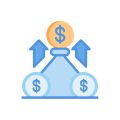1. Understanding the Basics: What Are 401(k)s and IRAs?
When it comes to saving for retirement in the U.S., two of the most popular options you’ll hear about are 401(k) plans and IRAs (Individual Retirement Accounts). Both accounts offer tax advantages and help you build a nest egg for your future, but they have different rules and benefits that can make one a better fit depending on where you are in your career. Let’s break down the basics so you can see what each has to offer.
Key Features at a Glance
| 401(k) | IRA | |
|---|---|---|
| Who Can Open | Employees with access through their employer | Anyone with earned income (even if self-employed) |
| Who Manages It | Your employer, usually through a plan administrator | You manage it yourself (or with help from a financial provider) |
| Contribution Limits (2024) | $23,000 (plus $7,500 catch-up if 50+) | $7,000 (plus $1,000 catch-up if 50+) |
| Employer Match | Often available; free extra money toward retirement | No employer match; all contributions are your own |
| Tax Benefits | Traditional: pre-tax contributions Roth: after-tax contributions (if plan offers Roth option) |
Traditional: pre-tax or deductible contributions Roth: after-tax contributions |
| Investment Choices | Limited by employer’s plan options | Wide range of choices—stocks, bonds, funds, etc. |
| Required Minimum Distributions (RMDs) | Yes, starting at age 73 for both Traditional and Roth 401(k)s | Yes for Traditional IRA (age 73); No for Roth IRA during owner’s lifetime |
Similarities Between 401(k)s and IRAs
- Tax-Advantaged Growth: Both accounts let your investments grow tax-deferred or tax-free (with Roth versions), helping your savings compound faster.
- Pretax vs. Roth Options: Both offer traditional (pretax) and Roth (after-tax) versions so you can choose how you want to be taxed—now or later.
- Early Withdrawal Penalties: Taking money out before age 59½ usually means paying taxes plus a 10% penalty, though there are some exceptions.
Main Differences You Should Know About
- Employer Involvement: 401(k)s are set up by employers and often include matching contributions. IRAs are set up by individuals with no employer involvement.
- Contribution Limits: You can put away much more each year in a 401(k) than in an IRA—especially helpful as your salary grows.
- Investment Flexibility: IRAs generally offer more investment options than most 401(k) plans.
- Eligibility: Anyone with earned income can open an IRA, while 401(k)s require access through an employer.
The Bottom Line for Your Career Stage
If you’re early in your career or just starting out, an IRA is easy to open on your own and gives you full control over investments. If you have access to a workplace 401(k)—especially one with employer matching—it can help supercharge your savings as your earnings increase. Either way, understanding these key differences makes it easier to pick the right account for where you are now—and where you want to go next.
2. Early Career Considerations
When you’re just starting your career, thinking about retirement can feel a bit early—but it’s actually the perfect time to set yourself up for long-term success. Understanding the differences between a 401(k) and an IRA, and how each fits into your lifestyle, can help you make smart choices right from the start.
Job Mobility: Flexibility Matters
If you expect to change jobs frequently in your early career (which is pretty common in the U.S.), keep in mind:
| Account Type | Portability When Changing Jobs |
|---|---|
| 401(k) | May need to roll over to a new employers plan or an IRA when leaving a job |
| IRA | Stays with you no matter where you work; not tied to any employer |
This means IRAs are generally more portable, while 401(k)s might require some paperwork if you switch jobs often. However, if your employer offers a great 401(k), it’s usually worth joining while you’re there.
Employer Matches: Free Money on the Table
One big advantage of many 401(k) plans is the employer match. This is basically free money—your company contributes extra funds when you put money into your 401(k). For example, they might match 50% of what you contribute up to a certain percent of your salary.
How Employer Match Works
| If You Contribute… | Your Employer Might Add… | Total Contribution |
|---|---|---|
| $2,000/year | $1,000/year (50% match) | $3,000/year |
| $4,000/year | $2,000/year (50% match) | $6,000/year |
If your employer offers a match, it’s smart to contribute at least enough to get the full benefit before considering an IRA. Don’t leave free money on the table!
The Power of Starting Early: Compound Growth
No matter which account you choose—a 401(k), an IRA, or even both—the earlier you start saving, the more time your money has to grow thanks to compounding interest. Even small contributions can turn into something significant over time.
Example: Starting at Age 25 vs. Age 35*
| Start Age | Monthly Contribution | Total Savings by Age 65 (7% annual return) |
|---|---|---|
| 25 | $200 | $524,000+ |
| 35 | $200 | $245,000+ |
*For illustration only; actual returns may vary.
Bottom line: whichever account works best for your situation—go for it! The key is to begin as soon as possible so that your future self will thank you.
![]()
3. Mid-Career Decision Points
When you’re in the middle of your career, your financial picture often looks very different than it did when you started working. You probably have a higher salary, more job stability, and a clearer idea of your retirement goals. This stage brings new choices—and challenges—when deciding between a 401(k) and an IRA. Let’s break down how these factors can influence your decision and why diversification might be more valuable now than ever.
How Increased Earnings Impact Your Options
As your income grows, your ability to contribute more to retirement accounts also increases. Here’s a quick look at how contribution limits stack up for 2024:
| Account Type | Annual Contribution Limit | Key Consideration |
|---|---|---|
| 401(k) | $23,000 (plus $7,500 catch-up if age 50+) | Higher limit, often with employer match |
| Traditional or Roth IRA | $7,000 (plus $1,000 catch-up if age 50+) | Lower limit; income limits apply for Roth IRA contributions |
If you’re able to max out your 401(k), that’s a significant boost to your retirement savings. But don’t overlook the benefits of adding an IRA to the mix—especially if you want more investment choices or flexibility.
The Role of Job Stability and Employer Benefits
Mid-career is when many people settle into long-term roles and start taking full advantage of workplace benefits like 401(k) matching or profit-sharing. If your employer offers matching contributions, try to contribute enough to get the full match—it’s essentially free money.
Considerations When Sticking With One vs. Both Accounts
| Scenario | Best Option(s) | Why? |
|---|---|---|
| Stable job with strong 401(k) plan & good investments | Maximize 401(k); consider IRA for extra savings/diversification | Takes advantage of higher limits and employer match while expanding investment options with IRA |
| No employer match or limited 401(k) choices | Split between 401(k) and IRA; prioritize IRA for flexibility | You can control investments more directly through an IRA and may benefit from Roth options if eligible |
| Earning above Roth IRA phase-out limits | Focus on 401(k); consider backdoor Roth strategies if needed | Income limits might block direct Roth contributions, but high earners can still leverage tax-deferred growth in a 401(k) |
The Value of Diversifying Retirement Accounts
This stage is perfect for building a well-rounded retirement portfolio. By using both a 401(k) and an IRA, you gain access to different tax advantages, withdrawal rules, and investment options. For example, you might use your traditional 401(k) for pre-tax contributions while opening a Roth IRA for after-tax savings—giving you more flexibility when it comes time to withdraw funds in retirement.
In summary, mid-career professionals should weigh their earning power, job stability, and available employer benefits when choosing between a 401(k) and an IRA. Using both can help you maximize contributions, diversify your investments, and build a stronger foundation for the future.
4. Pre-Retirement Planning
What to Consider as Retirement Approaches
As you get closer to retirement, the way you manage your 401(k) and IRA becomes even more important. Nows the time to make sure youre maximizing every opportunity to grow your savings and minimize taxes. Here’s what you should focus on:
Catch-Up Contributions
If you’re 50 or older, both 401(k)s and IRAs let you contribute extra money each year—this is called a catch-up contribution. For 2024, you can put an extra $7,500 into your 401(k), and $1,000 more into your IRA beyond the standard limits. This can make a big difference if you need to boost your retirement funds quickly.
| Account Type | Standard Limit (2024) | Catch-Up Contribution (50+) | Total Possible Contribution |
|---|---|---|---|
| 401(k) | $23,000 | $7,500 | $30,500 |
| IRA (Traditional/Roth) | $7,000 | $1,000 | $8,000 |
Rollover Strategies
If you’ve changed jobs throughout your career, chances are you have more than one retirement account. Consolidating old 401(k)s into an IRA can simplify your investments and sometimes give you more options and lower fees. But be careful: rolling over funds could affect your tax situation or future withdrawal rules. Always check with a financial advisor before making any big moves.
When Should You Consider a Rollover?
- You have several old 401(k)s from previous jobs.
- You want more control over investment choices.
- You’re seeking lower account fees or better customer service.
- You’re planning for Required Minimum Distributions (RMDs).
Balancing Multiple Retirement Accounts
It’s common to have both a 401(k) and an IRA, especially if you’ve been saving for years. Balancing these accounts means paying attention to how much risk you’re taking in each one, how much you’re paying in fees, and making sure your investments work together toward your goals. It also helps to review beneficiary designations and update them as life changes.
- Diversification: Spread out your investments across different asset classes to manage risk.
- Fees: Compare expense ratios between accounts—small differences add up over time.
- Tax Strategy: Understand which accounts are taxable or tax-free when withdrawn so you can plan distributions wisely.
Key Takeaways for Pre-Retirement Planning
- Take advantage of catch-up contributions if you’re 50 or older.
- Consider consolidating multiple accounts for easier management.
- Review your investment mix and fee structure regularly.
- Start thinking about withdrawal strategies to reduce taxes in retirement.
5. Making Your Choice: Key Questions to Ask Yourself
Checklist: Find the Right Fit for Your Retirement Needs
Choosing between a 401(k) and an IRA isn’t just about numbers—it’s about your lifestyle, career plans, and what you want your future to look like. Use this checklist of questions to help figure out which account lines up with your goals, values, and daily life.
Personal and Career Considerations
| Question | Why It Matters | If YES… | If NO… |
|---|---|---|---|
| Does my employer offer a 401(k) with a match? | Employer matching is basically free money for retirement savings. | Aim to contribute at least enough to get the full match. | Consider opening an IRA for more control and options. |
| Do I expect to change jobs frequently? | Frequent job changes can make managing old 401(k)s tricky. | An IRA may give you more flexibility and consolidation options. | A 401(k) might be convenient if you stay with one employer long-term. |
| Do I prefer having investment choices or simplicity? | Your comfort level with investing affects your experience. | If you want choices, IRAs usually offer more investment options. | If you like simple, a 401(k)’s pre-selected funds are easy to use. |
Financial Questions to Guide You
| Question | Why It Matters | If YES… | If NO… |
|---|---|---|---|
| Am I maxing out my 401(k) contribution limits? | You can save more in a 401(k) than an IRA each year. | Consider also opening an IRA for extra tax-advantaged savings. | You might focus on the 401(k) until you hit the limit, then add an IRA later. |
| Is my income too high for Roth IRA contributions? | There are income limits for direct Roth IRA contributions. | You might need to stick with a 401(k) or consider a “backdoor” Roth strategy. | You’re free to choose between Traditional and Roth IRAs. |
| Do I want to access my retirement money early (before age 59½)? | Each account has different rules and penalties for early withdrawals. | An IRA offers more exceptions (e.g., first-time home purchase, education). | A 401(k) may have stricter rules but some plans allow loans or hardship withdrawals. |
Lifestyle & Value-Based Questions
- Do I value hands-on control over my investments? If yes, an IRA gives you the driver’s seat. If not, a 401(k) keeps things simple with fewer decisions needed.
- How important is low maintenance? For set-it-and-forget-it savers, a 401(k) through work is almost automatic once you enroll.
- Are low fees a priority for me? Compare fees—some employer plans have higher costs than IRAs available through brokers or robo-advisors.
- Will I need financial advice or support? Some employers offer free financial counseling as part of their benefits, which could make sticking with a 401(k) easier if you want guidance along the way.
Your Next Steps: Review Your Answers
Your answers can point you in the right direction—there’s no single “right” account for everyone. The best fit depends on where you are in your career journey, how much flexibility you want, and what kind of support or independence feels right for your life right now. Take your time, weigh your options, and remember: it’s all about building the future that works for you!
6. Common Mistakes and How to Avoid Them
Real-World Pitfalls When Choosing or Managing Your Retirement Accounts
Deciding between a 401(k) and an IRA can feel overwhelming, especially if youre trying to make the right move for your career stage. Here are some common mistakes Americans make with their retirement accounts—and how you can sidestep them.
1. Not Taking Advantage of Employer Matches
One of the biggest perks of a 401(k) is employer matching. Too many people leave free money on the table by not contributing enough to get the full match.
| Mistake | How to Avoid It |
|---|---|
| Contributing less than the employer match threshold | Always contribute at least enough to get the full match—think of it as an instant return on your investment! |
2. Ignoring Account Fees
Fees might seem small, but over decades, they can eat up thousands of dollars from your retirement savings.
| Mistake | How to Avoid It |
|---|---|
| Not checking fund or account fees | Review your plans fee structure regularly and choose low-fee investment options when possible. |
3. Failing to Diversify Investments
Piling all your money into one fund or asset class can be risky—especially during market ups and downs.
| Mistake | How to Avoid It |
|---|---|
| Lack of diversification in portfolio | Select a mix of stocks, bonds, and other assets suitable for your age and risk tolerance. |
4. Forgetting About Old Accounts When Changing Jobs
It’s easy to lose track of old 401(k)s after switching employers, which may lead to forgotten savings or unnecessary fees.
| Mistake | How to Avoid It |
|---|---|
| Leaving old 401(k)s unmanaged after job changes | Consider rolling over old accounts into your new employers plan or an IRA to keep things organized and easier to manage. |
5. Withdrawing Early and Paying Penalties
Cashing out your retirement savings before age 59½ usually means taxes and penalties—plus you miss out on future growth.
| Mistake | How to Avoid It |
|---|---|
| Tapping into retirement funds early (unless absolutely necessary) | Avoid early withdrawals unless its a true emergency; look into loan or hardship options if needed, but understand the consequences first. |
Navigating Retirement Choices With Confidence
The key is staying informed, asking questions, and reviewing your accounts at least once a year. Small steps now can mean big rewards later—so take charge and build the retirement you want!


